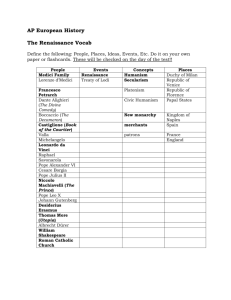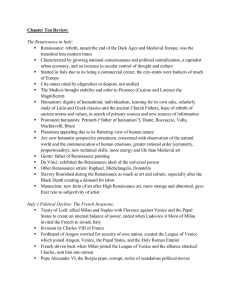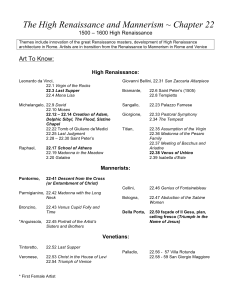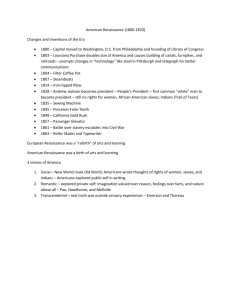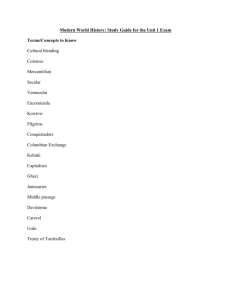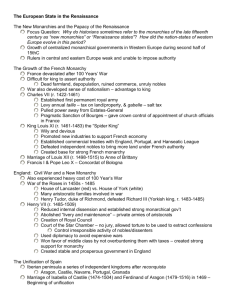Unit 1 Test: Study Guide
advertisement
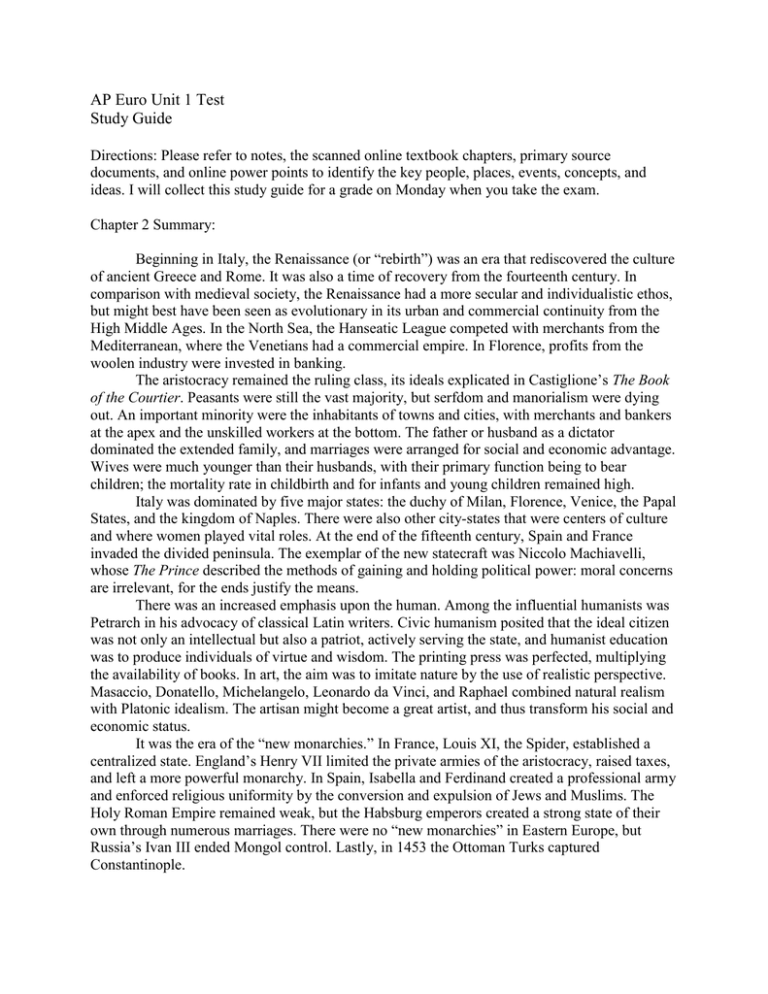
AP Euro Unit 1 Test Study Guide Directions: Please refer to notes, the scanned online textbook chapters, primary source documents, and online power points to identify the key people, places, events, concepts, and ideas. I will collect this study guide for a grade on Monday when you take the exam. Chapter 2 Summary: Beginning in Italy, the Renaissance (or “rebirth”) was an era that rediscovered the culture of ancient Greece and Rome. It was also a time of recovery from the fourteenth century. In comparison with medieval society, the Renaissance had a more secular and individualistic ethos, but might best have been seen as evolutionary in its urban and commercial continuity from the High Middle Ages. In the North Sea, the Hanseatic League competed with merchants from the Mediterranean, where the Venetians had a commercial empire. In Florence, profits from the woolen industry were invested in banking. The aristocracy remained the ruling class, its ideals explicated in Castiglione’s The Book of the Courtier. Peasants were still the vast majority, but serfdom and manorialism were dying out. An important minority were the inhabitants of towns and cities, with merchants and bankers at the apex and the unskilled workers at the bottom. The father or husband as a dictator dominated the extended family, and marriages were arranged for social and economic advantage. Wives were much younger than their husbands, with their primary function being to bear children; the mortality rate in childbirth and for infants and young children remained high. Italy was dominated by five major states: the duchy of Milan, Florence, Venice, the Papal States, and the kingdom of Naples. There were also other city-states that were centers of culture and where women played vital roles. At the end of the fifteenth century, Spain and France invaded the divided peninsula. The exemplar of the new statecraft was Niccolo Machiavelli, whose The Prince described the methods of gaining and holding political power: moral concerns are irrelevant, for the ends justify the means. There was an increased emphasis upon the human. Among the influential humanists was Petrarch in his advocacy of classical Latin writers. Civic humanism posited that the ideal citizen was not only an intellectual but also a patriot, actively serving the state, and humanist education was to produce individuals of virtue and wisdom. The printing press was perfected, multiplying the availability of books. In art, the aim was to imitate nature by the use of realistic perspective. Masaccio, Donatello, Michelangelo, Leonardo da Vinci, and Raphael combined natural realism with Platonic idealism. The artisan might become a great artist, and thus transform his social and economic status. It was the era of the “new monarchies.” In France, Louis XI, the Spider, established a centralized state. England’s Henry VII limited the private armies of the aristocracy, raised taxes, and left a more powerful monarchy. In Spain, Isabella and Ferdinand created a professional army and enforced religious uniformity by the conversion and expulsion of Jews and Muslims. The Holy Roman Empire remained weak, but the Habsburg emperors created a strong state of their own through numerous marriages. There were no “new monarchies” in Eastern Europe, but Russia’s Ivan III ended Mongol control. Lastly, in 1453 the Ottoman Turks captured Constantinople. The church was besieged by problems. John Wycliffe and John Huss condemned the papacy for corruption, its temporal concerns, and demanded the Bible in the vernacular. The popes reflected their era, and their secular involvements overshadowed their spiritual responsibilities. Some preferred war and politics to prayers and piety, and others ignored their vows of celibacy, ambitiously advancing their families over the needs of the faithful. Most were great patrons of the arts, but religious concerns ranked behind the pleasure of this life. The fifteenth and sixteenth centuries were an era of Western global expansion. Among the motives, economies ranked first, followed by religion and adventure or fame, or, as the text quotes, “Gold, glory, and gold.” It occurred when it did because of the emergence of centralized monarchies, sufficient wealth to finance such endeavors, and new technologies such as better maps and charts, more seaworthy ships, the compass and astrolabe, and knowledge of Atlantic winds. The first to venture forth were Portugal and Spain. Portuguese ships were exploring and trading along Africa’s west coast by the mid-fifteenth century, bringing back slaves and gold. Southern Africa was rounded in 1488, and India was reached in 1498, followed by the Malay Peninsula and the Spice Islands (Indonesia). The Portuguese empire was one of trade; its population was too small to establish large colonies, but Spain had greater resources. Seeking the same Asian goal as Portugal, the Italian Christopher Columbus, sailing for Spain, reached the Caribbean West Indies in 1492, believing it was part of Asia. It was not, and the new found land (to him) became known as the New World or America, after Amerigo Vespucci, an early geographer. Spanish conquistadors arrived on the mainland of Mesoamerica in 1519. Aztec resistance was quickly overcome thanks to assistance from other native states, gunpowder and horses, and European diseases such as smallpox; for which the native population had no immunity. In South America, the Incas were conquered by the 1530s. The natives became Spanish subjects, but were often exploited by Spanish settlers. Two viceroys (vice kings) ruled in Mexico City and Lima, Peru; Catholic missionaries under the control of the Spanish crown brought Christianity, including cathedrals, schools, and the inquisition, to the native population. Although originally less priced than gold and spies, slaves became a major object of trade, and by the nineteenth century ten million African slaves had been shipped to America. Slavery was common in Africa, and the African terminus of trade was in the hands of the Africans, but the insatiable demand for slaves led to increased warfare on the unfortunate continent. It was not until the late 1700s that slavery came under criticism in Europe. The Dutch expelled Portugal from the Spice Islands by 1600, and in India, the British East India Company controlled the Mughal Empire by the mid-1700s. Trade with China was limited, its rulers believing the West offered nothing that China needed, and Japan gave only the Dutch even minimal trading rights. In the New World, the Dutch, French, and the British also established colonies. Eventually British North America consisted of thirteen colonies. France established an empire in Canada, but its French population remained small. In Europe, a commercial revolution led to integrated markets. Joint-stock trading companies, and banking and stock exchange facilities. Mercantilist theory posited that a nation should acquire as much gold and silver as possible, there must be a favorable balance of trade, or more exports than imports, and the state would provide subsidies to manufactures, grant monopolies to traders, build roads and canals, and impose high tariffs to limit imports. The impact of European expansion was mixed. In the Americas, the native culture was largely destroyed and a new multiracial society evolved. That was less true in British America, which became mainly European in population and culture. The Columbian exchange saw Europeans bringing horses, cattle, sugarcane, wheat, as well as disease and gunpowder to the New World and adopting the potato, maize (corn), and chocolate in turn. Native cultures were least affected in Asia, particularly Japan and China. Missionaries, mostly Catholic, were mainly successful in the New World, and within Europe, imperial rivalries could lead to war. Key topics, people, places, ideas & Concepts: (give a brief description of each) Black Death Conciliar Movement Hundred Year’s War Great Russians, White Russians, Little Joan of Arc Pope Innocent III Pope Urban IV Pope Boniface VIII Unam Sactum Babylonian Captivity Pope John XXII John Wycliffe John Huss Lollards & Hussites Great Schism Pope Urban VI Pope Alexander V Russians Boyars Genghis Khan Treaty of Lodi Cosimo de Medici Lorenzo the Magnificent The Visconti Family & Sforza Family League of Venice Venice Merchant oligarchy Humanism Baldassare Castiglione Book of the Courtier Platonic Academy Francesco Petrarch Motive for Exploration Dante Alighieri the Divine Comedy Portuguese and Spanish Empires The Decameron by Govani Boccaccio Slave Trade Linear perspective Columbian Exchange Michelangelo Buonarroti Mercantilism Leonardo da Vinci Commercial Capitalism Raphael Big topics to understand: Brothers of the Common life (Northern The Family Structure and life of Women Renaissance) during the Renaissance Johann Guttenburg—Printing Press Difference between Italian and Northern Desiderius Erasmus Thomas Moore, Utopia Christopher Columbus Amerigo Vespucci Ferdinand Magellan Henry the Navigator Renaissance Structure and Function of Italian States Birth of politics with Machiavelli Impact of the Printing Press The Renaissance Papacy Essay topics Write an essay that: • Has a relevant thesis. • Addresses all parts of the question. • Supports thesis with specific evidence. • Is well organized Analyze the educational and social opportunities and/or limitations for upper and merchant class women in Renaissance society. Analyze the influence of humanism on the visual arts in the Italian Renaissance. Use at least THREE specific works to support your analysis. Using examples from at least two different states, analyze the key features of the “new monarchies” and the factors responsible for their rise in the period 1450 to 1550. Analyze the effects of the Columbian exchange (the interchange of plants, animals, and diseases between the Old World and the New World) on the population and economy of Europe in the period 1550 to 1700
